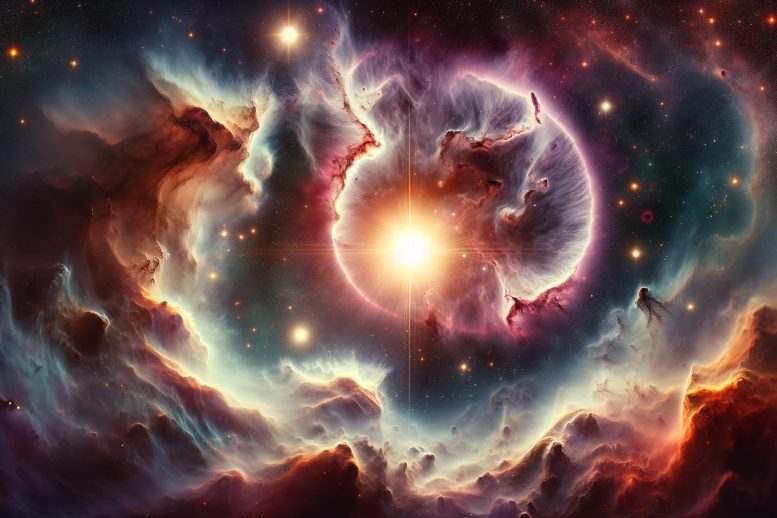
Research using the James Webb Space Telescope on the Orion Nebula’s protoplanetary disc d203-506 shows massive stars’ critical role in planetary system formation, affecting the possibility of Jupiter-like planet formation. Credit: SciTechDaily.com
An international team used the James Webb Space Telescope to study a protoplanetary disc in the Orion Nebula, revealing how massive stars significantly influence the formation of planetary systems. They discovered that intense ultraviolet radiation from these stars can prevent the formation of Jupiter-like planets in systems like d203-506, providing new insights into the complexities of how planetary systems develop.
How do planetary systems such as the Solar System form? To find out, CNRS scientists taking part in an international research team[1] studied a stellar nursery, the Orion Nebula, using the James Webb Space Telescope.[2] By observing a protoplanetary disc named d203-506, they have discovered the key role played by massive stars in the formation of such nascent planetary systems.[3]
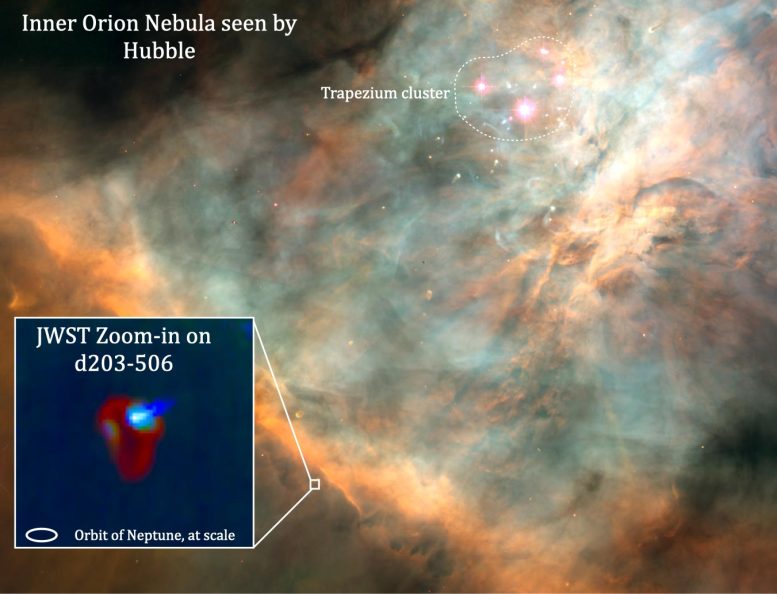
Hubble image of the Orion Nebula, and a zoom in on the protoplanetary disc d203-506 taken with the James Webb Space Telescope (JWST). Credit: NASA/STScI/Rice Univ./C.O’Dell et al / O. Berné, I. Schrotter, PDRs4All
These stars, which are around 10 times more massive, and more importantly 100,000 times more luminous than the Sun, expose any planets forming in such systems nearby to very intense ultraviolet radiation. Depending on the mass of the star at the center of the planetary system, this radiation can either help planets to form, or alternatively prevent them from doing so by dispersing their matter. In the Orion Nebula, the scientists found that, due to the intense irradiation from massive stars, a Jupiter-like planet would not be able to form in the planetary system d203-506.
This paper, which made the front page of the journal Science on March 1st, 2024, shows with unprecedented precision the decisive role played by massive stars in shaping planetary systems, and opens up new perspectives on how such systems form.
For more on this discovery:
- Webb Space Telescope Unveils the Invisible Forces That Sculpt Planetary Systems
- Ultraviolet “Winds” Erode a Young Star’s Protoplanetary Disk in Orion Nebula
Notes
- The main French laboratories involved in this study are: the Institut de Recherche en Astrophysique et Planétologie (CNES/CNRS/Université Toulouse Paul Sabatier), Institut d’Astrophysique Spatiale (CNRS/Université Paris-Saclay), Laboratoire d’Etudes du Rayonnement et de la Matière en Astrophysique et Atmosphères (CNRS/Université Cergy Paris/Observatoire de Paris-PSL/Sorbonne Université/), and Institut des Sciences Moléculaires d’Orsay (CNRS/Université Paris Saclay). The study is part of the international ‘ PDRs4All ‘ project.
- The James Webb Infrared Space Telescope can peer through dust clouds, thus revealing with unparalleled clarity distant celestial bodies such as the Orion Nebula, 1400 light-years from Earth.
- Systems that are less than a million years old.
Reference: “A far-ultraviolet–driven photoevaporation flow observed in a protoplanetary disk” by Olivier Berné, Emilie Habart, Els Peeters, Ilane Schroetter, Amélie Canin, Ameek Sidhu, Ryan Chown, Emeric Bron, Thomas J. Haworth, Pamela Klaassen, Boris Trahin, Dries Van De Putte, Felipe Alarcón, Marion Zannese, Alain Abergel, Edwin A. Bergin, Jeronimo Bernard-Salas, Christiaan Boersma, Jan Cami, Sara Cuadrado, Emmanuel Dartois, Daniel Dicken, Meriem Elyajouri, Asunción Fuente, Javier R. Goicoechea, Karl D. Gordon, Lina Issa, Christine Joblin, Olga Kannavou, Baria Khan, Ozan Lacinbala, David Languignon, Romane Le Gal, Alexandros Maragkoudakis, Raphael Meshaka, Yoko Okada, Takashi Onaka, Sofia Pasquini, Marc W. Pound, Massimo Robberto, Markus Röllig, Bethany Schefter, Thiébaut Schirmer, Thomas Simmer, Benoit Tabone, Alexander G. G. M. Tielens, Sílvia Vicente, Mark G. Wolfire, PDRs4All Team†, Isabel Aleman, Louis Allamandola, Rebecca Auchettl, Giuseppe Antonio Baratta, Clément Baruteau, Salma Bejaoui, Partha P. Bera, John H. Black, Francois Boulanger, Jordy Bouwman, Bernhard Brandl, Philippe Brechignac, Sandra Brünken, Mridusmita Buragohain, Andrew Burkhardt, Alessandra Candian, Stéphanie Cazaux, Jose Cernicharo, Marin Chabot, Shubhadip Chakraborty, Jason Champion, Sean W.J. Colgan, Ilsa R. Cooke, Audrey Coutens, Nick L.J. Cox, Karine Demyk, Jennifer Donovan Meyer, Cécile Engrand, Sacha Foschino, Pedro García-Lario, Lisseth Gavilan, Maryvonne Gerin, Marie Godard, Carl A. Gottlieb, Pierre Guillard, Antoine Gusdorf, Patrick Hartigan, Jinhua He, Eric Herbst, Liv Hornekaer, Cornelia Jäger, Eduardo Janot-Pacheco, Michael Kaufman, Francisca Kemper, Sarah Kendrew, Maria S. Kirsanova, Collin Knight, Sun Kwok, Álvaro Labiano, Thomas S.-Y. Lai, Timothy J. Lee, Bertrand Lefloch, Franck Le Petit, Aigen Li, Hendrik Linz, Cameron J. Mackie, Suzanne C. Madden, Joëlle Mascetti, Brett A. McGuire, Pablo Merino, Elisabetta R. Micelotta, Jon A. Morse, Giacomo Mulas, Naslim Neelamkodan, Ryou Ohsawa, Roberta Paladini, Maria Elisabetta Palumbo, Amit Pathak, Yvonne J. Pendleton, Annemieke Petrignani, Thomas Pino, Elena Puga, Naseem Rangwala, Mathias Rapacioli, Alessandra Ricca, Julia Roman-Duval, Evelyne Roueff, Gaël Rouillé, Farid Salama, Dinalva A. Sales, Karin Sandstrom, Peter Sarre, Ella Sciamma-O’Brien, Kris Sellgren, Matthew J. Shannon, Adrien Simonnin, Sachindev S. Shenoy, David Teyssier, Richard D. Thomas, Aditya Togi, Laurent Verstraete, Adolf N. Witt, Alwyn Wootten, Nathalie Ysard, Henning Zettergren, Yong Zhang, Ziwei E. Zhang and Junfeng Zhen, 29 February 2024, Science.
DOI: 10.1126/science.adh2861

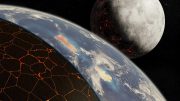
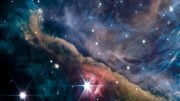

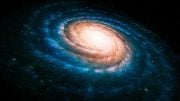




Be the first to comment on "Radiation From Massive Stars – 100,000 Times More Luminous Than the Sun – Shapes Planetary Systems"